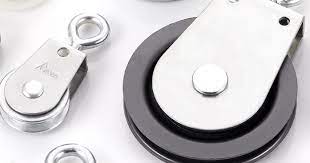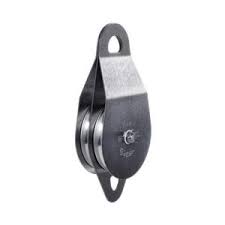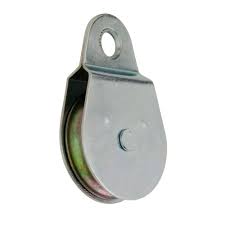Product Description
Product Description
The role of elevator guide wheels:
increase the distance between the car and the counterweight and change the direction of movement of the wire rope. The elevator guide wheel has a pulley structure, and its role is to save the effort of the pulley
block.
|
Product Name |
Elevator Deflector Sheave |
|
Diameter |
φ240 – φ640 |
|
Number of Slots |
2 – 10 |
|
Rope |
6.5 – 13 |
|
Slot Pitch |
10 – 20 |
Detailed Photos
Different Models
Main Product Catalog
Company Profile
Exhibition
Packaging & Shipping
Why Choose Us
| Type: | Elevator Sheave |
|---|---|
| Suitable for: | Elevator |
| Load Capacity: | 2000kg |
| Persons: | 11-20 |
| Speed: | 1.00-2.00m/s |
| Drive Mode: | AC |
| Customization: |
Available
| Customized Request |
|---|

Can rope pulleys be employed in both commercial and residential settings?
Yes, rope pulleys can be employed in both commercial and residential settings. Here’s a detailed explanation:
Commercial Settings:
In commercial settings, rope pulleys find a wide range of applications:
1. Construction and Rigging: Rope pulleys are extensively used in construction and rigging operations. They are employed for lifting and moving heavy materials, equipment, or scaffolding systems. Pulleys with high load capacities and robust construction are utilized to ensure safety and efficiency in commercial construction projects.
2. Entertainment and Stage Rigging: Rope pulleys are commonly utilized in the entertainment industry for stage rigging, theatrical productions, and concerts. They enable the raising and lowering of props, scenery, and lighting fixtures. Pulley systems with smooth operation and precise control are essential for the seamless execution of performances.
3. Cargo Handling and Transportation: Rope pulleys play a significant role in cargo handling and transportation industries. They are employed in systems such as cranes, hoists, and elevators to facilitate the movement of goods and materials. Pulleys with high load capacities, durability, and reliable braking mechanisms are utilized to ensure safe and efficient cargo transportation.
Residential Settings:
In residential settings, rope pulleys can be employed in various applications:
1. Clotheslines and Drying Racks: Rope pulleys are commonly used in clothesline systems and drying racks in residential properties. They allow for easy hanging and retracting of clothes, maximizing outdoor drying space and convenience.
2. Home Gym and Exercise Equipment: Rope pulleys can be incorporated into home gym setups and exercise equipment. They are employed in cable machines, weightlifting systems, and resistance training devices to provide adjustable resistance and smooth movement during workouts.
3. Garage and Storage Systems: Rope pulleys can be utilized in garage and storage systems for overhead storage solutions. They enable the lifting and lowering of items such as bicycles, kayaks, or storage containers, maximizing the use of vertical space.
4. Window Treatments: Rope pulleys are sometimes used in residential window treatments, such as Roman shades or blinds. They facilitate the raising and lowering of window coverings, allowing for adjustable light control and privacy.
It’s important to note that while rope pulleys can be employed in both commercial and residential settings, the specific requirements and considerations may vary. In commercial settings, factors such as load capacity, durability, and adherence to industry regulations are crucial. In residential settings, considerations may include ease of use, convenience, and aesthetics.
The selection and installation of rope pulleys in commercial and residential settings should be carried out in accordance with relevant safety guidelines and manufacturer recommendations to ensure proper functionality and user safety.

How does the groove design of a rope pulley impact its performance?
The groove design of a rope pulley plays a significant role in its performance and the overall efficiency of the pulley system. Here’s a detailed explanation of how the groove design impacts pulley performance:
1. Friction and Wear: The groove design affects the frictional interaction between the rope and the pulley. A well-designed groove minimizes friction, reducing wear on both the rope and the pulley itself. Smooth and rounded groove profiles help prevent excessive abrasion or damage to the rope, leading to improved durability and longevity.
2. Grip and Traction: The groove design determines the grip and traction between the rope and the pulley. An appropriate groove profile ensures sufficient contact between the rope and the pulley, preventing slippage during lifting or movement. Adequate grip and traction are crucial for maintaining control and stability in the pulley system.
3. Efficiency and Mechanical Advantage: The groove design affects the efficiency of force transmission and the mechanical advantage obtained from the pulley system. A well-designed groove reduces energy losses due to friction, allowing for more efficient transfer of force. The shape, depth, and width of the groove influence the angle of rope contact and the distribution of force, impacting the mechanical advantage achieved.
4. Rope Compatibility: The groove design should be compatible with the type and diameter of the rope used. Different ropes have varying characteristics, such as flexibility, diameter, and surface texture. The groove design should accommodate the specific rope properties, ensuring proper fit and engagement. This compatibility ensures optimal performance and prevents rope slippage or damage.
5. Debris and Contaminant Clearance: The groove design should facilitate the clearance of debris, dirt, or contaminants that may accumulate during operation. Grooves with appropriate depth, width, and self-cleaning features prevent the build-up of foreign substances, maintaining smooth rope movement and consistent performance.
Overall, the groove design of a rope pulley impacts its performance by influencing friction, wear, grip, traction, efficiency, mechanical advantage, rope compatibility, and debris clearance. Engineers and designers consider these factors when selecting or designing pulleys to optimize performance, reduce wear and tear, and ensure safe and reliable operation of the pulley system.

How do rope pulleys assist in lifting and moving heavy loads?
Rope pulleys play a crucial role in lifting and moving heavy loads by providing mechanical advantage and facilitating the transfer of force. Here’s a detailed explanation of how rope pulleys assist in these tasks:
1. Mechanical Advantage: Rope pulleys are designed to increase the mechanical advantage in lifting and moving operations. They achieve this by redirecting the force applied to the rope, making it easier to lift or move heavy loads. The mechanical advantage obtained depends on the configuration of the pulley system used.
2. Change in Direction: Rope pulleys change the direction of the force applied to the rope. By redirecting the force, they enable lifting and moving loads in a controlled manner. For example, a pulley system can change the direction of the force from a vertical pull to a horizontal pull, allowing for the movement of loads along different paths.
3. Load Distribution: Rope pulleys distribute the load across multiple ropes or cables. By using multiple pulleys in a system, the load can be divided among the ropes, reducing the strain on each individual rope. This load distribution helps prevent overload and promotes safer lifting and moving operations.
4. Increased Efficiency: Rope pulleys enhance the efficiency of lifting and moving heavy loads. By reducing the effort required to lift the load, they allow operators to exert less force while achieving the desired movement. This increased efficiency translates to improved productivity and reduced physical strain on the operators.
5. Versatility and Flexibility: Rope pulley systems offer versatility and flexibility in lifting and moving applications. They can be easily adapted to different load sizes and weights by adjusting the number and arrangement of pulleys. This adaptability enables efficient handling of a wide range of loads in various industries and settings.
Overall, rope pulleys provide mechanical advantage, change the direction of force, distribute loads, increase efficiency, and offer versatility in lifting and moving heavy loads. Their use in various industries and applications significantly improves productivity, safety, and operational effectiveness.


editor by CX
2023-10-16